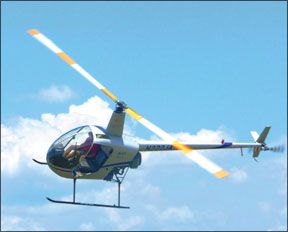Dateline 1991: The aircraft economic climate was stronger than in the current world, and Frank Robinsons tiny two-place piston helicopter outsold every manufacturer of general aviation aircraft in the U.S.
Thats impressive since fixed-wing operations outnumber rotor ops at most GA airports. Helicopters can easily clobber the average operating budget and have limited mission profiles. They arent exactly simple to pilot, either. But the R22 is more than an entry-level and lower-cost machine. Its versatile and up for the challenge to support numerous mission profiles including airborne law enforcement, aerial photography and personal travel missions.
The pint-sized machine found a huge market because it did what no other helicopter could do: it offered a relatively cheap means of getting into the world of rotors. It has enough performance to serve personal and commercial applications at acquisition and operating costs that beat anything the turbine chopper market can offer. To date, more than 3600 R22s have been delivered to more than 60 countries. In the personal helicopter market, this is saying something.
Evolution of the robbie
Observing a keep-it-simple dictum since the first Robinson rolled off the assembly line at the Torrance, California, plant in 1979, the company has hewed to basics, making only incremental improvements and refinements and no drastic model changes. The first R22s had 150-HP Lycoming engines de-rated to 124 HP. When it was introduced, the Robinson engine and airframe had a phenomenal TBO of 2000 hours. That has since been inched to 2200 hours, but there’s a catch to this which you’ll see in a moment.
The HP model came along in 1981 with a 160-HP, B2C engine. Although the powerplant was still de-rated to 124 HP, the pilot could pull the extra power at any time, since there are no artificial stops. And the extra throttle would provide a minimal cushion in high-density altitude situations.
In 1983, the factory pumped out the Alpha instrument trainer, with the gross weight boosted from 1300 to 1370 pounds to lug around all the extra instruments and avionics. Its not uncommon to find Bendix/King KCS55A HSI systems and GNS430W WAAS navigator upgrades in these instrument trainers. At the same time, changes were made in the structure and control system to widen the CG range. The battery was moved from the nose to the engine compartment and the aft main strut was lengthened to give extra clearance for the tail rotor.
In 1985, the Beta model upped the ante in horsepower from 124 HP to 131 HP. And a year later, an amphibious Mariner model was brought out with fixed floats that are attached to a special skid gear. The entire arrangement can be removed and replaced with the standard skids. The floats arent the instantly inflatable variety found on other helicopters.
Performance, Handling
There are no hydraulics in the R22 to dampen sloppy control inputs, so its easy to get squirrely if you get out of the bubble. The R22 will bust any ego that has only experienced stabilized, turbine rotorcraft. you’ll need a delicate touch on the controls, which is the case with most small copters. Its safe to say that if you arent always actively flying the R22, soon you wont be flying at all.
The R22 is not fast but as helicopters go, but its no slouch for its power. Max cruise is listed at 102 knots and usual operations in station to station cruise put the needle around 95 knots. Offerings from Schweizer and Enstrom struggle to catch the R22. An experienced instructor told us students usually fly the Robbie
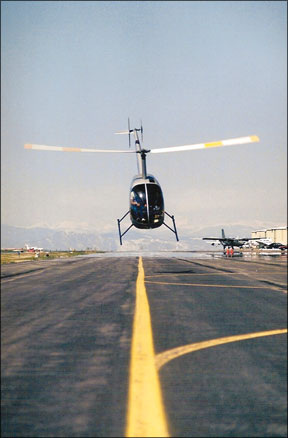
around 80 knots. But the speed is there for the taking.
In maximum hovering altitude out of ground effect, the R22 again comes through with respectable numbers. For the R22 Beta, HOGE is 5200 feet, compared with only 2750 feet for the Schweizer 300C. The Enstrom F28F outshines the R22 in this category, however, with a HOGE of 8700 feet. The R22 Beta II model has a max hovering in ground effect altitude of 9400 feet, however.
The rotor blades are a low-inertia design, which means decaying rotor speed can quickly whack an inattentive pilot between the eyes. In the early days of the R22, this was mentioned as the probable cause of airframe breakups as the main rotor blades, in slowing down, struck the airframe. It is also generally cited as making for a more “dramatic” critically timed flare at the bottom of an autorotation. Early on in R22 training, instructors stress the importance of quickly lowering the collective-you have less than two seconds-in a real-deal or simulated loss of engine power. This reaction is also critical in hovering autorotations.
But with bad habits comes good. For example, the mechanical throttle/collective coordination of the R22 is remarkably good at matching engine RPM output to collective movements. Robinson has the ergonomics down, which includes an easy-to-interpret rotor/engine tach gauge. On top of this, Robinson has made standard an electronic throttle governor to hold a constant RPM as the collective is moved up and down. This is something every pilot who has flown turbine helicopters desires, because the nagging concern about maintaining rotor RPM throughout various maneuvers is largely eliminated with the automatic throttle response.
A few training operations we spoke with take the same attitude toward training on the R22 as the factory has aggressively pushed. Robinson is outspoken in addressing any design-related safety issues with a training program that should serve as a model for the industry. The thread is simple: When you pilot an R22 your training has you understanding and recognizing the machines limitations and manners. This training campaign seems to have lowered the accident rate. Still, the R22, or any helicopter for that matter, is no place for the uninformed. Nobody has demonstrated an autorotation from higher than 10 feet and slower than 45 knots that hasnt broken metal in the R22.
Creature comforts
The one odd and seemingly little-league control arrangement on the Robinson is a teetering handlebar or T-Bar cyclic control. This is mounted on a single control column that feeds up through the floor at the base of the instrument pedestal. When the student has one handle and is resting his hand on his leg for stability, the other handle is teetered rather high for the instructor, who should be ready to

take over at any given time. The accident reports are full of days where instructors should have had more caffeine before going flying with newbie students.
The cabin of the R22 requires headsets, but isn’t as noisy as you might expect. Its on par with a Cherokee or Skyhawk. You can almost get away with a voice-activated intercom in an R22 (which isn’t the case in many helicopters). Of course, there’s also the added vibration from all those spinning parts that adds a bit of drama to the environment. For brand new pilots, eyeing those blades as they whirl by the bubble windshield is at first disconcerting. Welcome to the world of helicopters.
The instrument panel in an R22 doesnt get more basic. In most ships, the flight instruments include airspeed, vertical speed, altimeter, engine/rotor tachometer and manifold pressure. Engine instruments include oil pressure and temperature and cylinder head temperature. The cluster is nicely arranged and everything is somewhat easy to access for maintenance. The avionics stack is fairly stark, as these are fair-weather helicopters.
But avionics upgrades are definitely doable. The Robbie has a 14-volt electrical system that can handle a decent suite of electronics. Vibrating airframes tend to eat gyro instruments, and since these instruments are electrically-driven, they are high-price items.
By no means is the R22 intended for rotoring into IMC. You can load all the latest and greatest avionics in but this is a VFR-only machine. Still, its extremely economical for earning and instrument rating and many flight schools capitalize. Its also well-thought-out for the pilot flying. Robinson has thoughtfully put frequency memory and active/standby switches on the pilots side cyclic so you
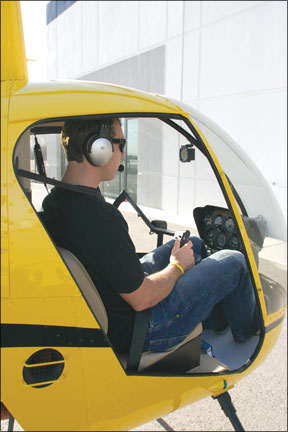
don’t have to reach for the radio. It adds a big helicopter touch.
No Big Pilots or High Ops
Passenger and baggage capacity with a full 30 gallons of fuel is about 310 pounds in a typical modern R22 Beta II. Baggage-and we use that term lightly-is stowed underneath the seats. Plan to travel lightly in these helicopters.
The R22 can be a bit awkward to get in and out of, but its a comfortable dwelling once youre settled. Crushable seats absorb much of the energy in a crash, which is why you want to be careful in what you store underneath them.
More than one flight school told us theyve added the larger and competitor Schweizer models to their flight lines because the R22 isn’t always up to the task when loaded to the max. One instructors rule of thumb is 240/160, which means a heavyweight in one seat only leaves room for a lightweight in the other.
Look real hard at the loading weight and temperature when planning run-ons in confined areas. The wreck reports reveal a fair number of R22 missions gone badly at high density altitudes. The Robbies normally-aspirated Lycoming runs out of steam as the air gets thinner. The rule is to not attempt takeoffs unless you can hover.
Operating costs
Pilots and operators who responded to our call for feedback almost universally reported the R22 as a reliable and relatively trouble-free machine. As in previous studies, most owners said it was less of a burden than with any other helicopter in their experience, and some readers own both airplanes and the R22. On top of that, the factory is often praised with excelling in customer service and part support.
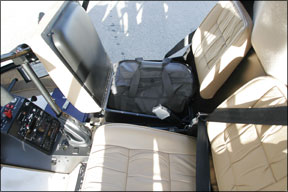
To say that parts are easily available is not to say they are cheap, any more than with any helicopter. The estimated maintenance cost tally from $6 to $12 an hour, not counting reserve for overhaul. A look at the factorys numbers on the R22 Beta II offers a general summary of what it takes to operate this machine: Insurance for a 200 hours logged helicopter pilot with a clean record is $8050 per year. Direct operating costs including fuel for $4.50 low-lead and eight gallons per hour average (8-11 gallons per hour is more realistic), periodic inspections, unscheduled maintenance, parts and labor totals a $49.98 per hour. Add $50.98 per hour in anticipation for the big overhaul and you end up with a total operating cost of $117.06 per hour.
Since helicopters fly low and relatively slow, its worth comparing the costs per road mile. If one air mile equals one and one half road miles using 110 MPH burning 9.5 gallons per hour, the R22 would cost 75 cents per road mile. The factory skillfully likens this number to operating an expensive automobile. And arriving in your own helicopter is far sexier than arrival in a car.
One experienced owner who uses an R22 for photo missions told us he counts on paying out roughly twice as much to maintain an R22 as a Cessna 172 he used to use. Still, using that $117 per hour factory number and its in the same ballpark as, say, a high-performance fixed wing. Another aerial photographer loves the R22 for its cost. He told us it does nearly everything he needs it to do, if a bit small. Try leasing a Jet Ranger for under $400 per hour.
AD, SDRs
When we first reviewed the R22, we found that the biggest number of apparent glitches involved worn or failed tail rotor pitch link and teeter hinge bearings, with a dozen instances reported. If thats still a problem, we havent seen any evidence
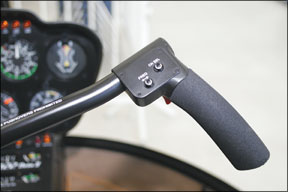
of it in the Service Difficulty Reports (SDRs). A more recent AD may also be the most onerous. Emergency AD 2004-06-52 requires track and balancing of the main rotors within 10 flight hours if theyre older than five years or have 1000 hours time in service. The blades must be replaced if an abnormal increase in vibration occurs within five hours of the track-and-balance. The AD also requires immediate replacement of certain blades, whose part numbers are given in the AD.
Other ADs of note include 2000-20-51, which requires inspection for yoke cracking, AD 99-07-17 which calls for inspection/replacement of the sprag clutch; AD 99-02-02, requiring inspection and/or replacement of the flexplate; AD 98-21-09 for fuel tank vent check; AD 97-25-05 for carburetor and carb temp gauge replacement and 97-02-14, which requires an improved throttle governor, superceding and supplementing a previous AD on the subject.
A sweep of a couple of years worth of service difficulty reports revealed no patterns of concern and few issues worth remarking about. There were a couple of incidents involving loose or defective drive belts and comments on sprag clutches. But, as owners insist, the R22 is not a difficult-to-maintain aircraft.
The Big Overhaul
One unusual aspect of maintaining the R22 involves planning for a complete overhaul of engine, airframe and rotors at 2200 hours or 12 years, whichever comes first. The base price of this overhaul, including the engine, is $134,000 as of this writing. Naturally, this major overhaul has owners eyeballing the cost of a replacement ship. A new R22 Beta II has a starting price of $257,000 including basic avionics and cabin heater. Low-time used machines can be had for around $150,000.
The factory lists reserve pricing for the big overhaul at $50.98 per hour. The 2200-hour engine overhaul is $26,400 and the aircraft overhaul is $70,000 with 225 man hours of labor at $70 per hour. When the R22 comes out of this factory overhaul, it is a completely reconditioned machine. Since key components like the main rotor blades have 2200-hour lifetimes, they are replaced. The Lycoming powerplant has a 2200-hour recommended TBO, so Robinson provides an overhauled replacement engine. The interior is replaced, too, and the rotorcraft gets a new paint job. Robinson does both the airframe and engine overhaul, having established an engine overhaul shop at Torrance.
Owners must, however, figure on flying or shipping the R22 to and from Torrance
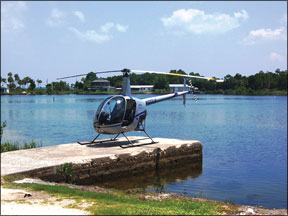
and thats a cost owners gripe about, wishing there were other factory overhaul facilities around the country. For East Coast operators, Northeast Helicopters in Ellington, Connecticut, has been operating a fleet of R22s for years, and has performed enough total overhauls on their and customer ships to be considered as good as the factory, in our view. Theyre also an extremely structured helicopter flight school. Notable West Coast facilities include Civic Helicopters in Carlsbad, California. Of course, you can go to the factory and deal with six to eight weeks for a factory overhaul. There are about 200 service centers around the world, with over 100 in the U.S.
Modifications
Aerial photography really requires a photo door. Tech-Tool Plastics in Texas makes one (www.tech-tool.com). The door is under $3000 and has a full-view plastic assembly with a vertical sliding window for camera-pointing. Tech-Tool also sells replacement glass for R22.
For making the R22 a heavy lifter, Onboard Systems (www.onboardsystems.com) offers the Talon series certified cargo hook that can lift 400-pound loads. Its designed for easy installation and the total kit only weighs around five pounds.
Simplex Manufacturing (www.simplexmfg.com) makes the Helipod external luggage pod. There’s also a similar product for agricultural spraying missions. An autogas STC for the R22 can be purchased from Solatec Corp (www.solatec-corp.com) in New Hampshire.
The owners group for Robinsons is at http://www.robinsonhelicopter.org/.
Owner Feedback
I am still the proud owner of R22, Beta II N222JA that I purchased new in March of 2000. The aircraft is now approaching 1200 hours total time, and it still runs and looks like new.
As a 22,000-hour professional pilot, I enjoy the fact that the thing keeps on working. There are oil changes, spark plugs every couple of years, the 300-hour valve reaming per SB388, exchange the magnetos every 500 hours or four years, the almost rare track-and-balance work, and, of course, annual inspections. The only major issue was when Robinson required all the rotor blades in the field to be upgraded from the original -2 blades to the newer -4 Stainless Steel blades. They sold everyone the new blades for $4995, instead of the retail price of just over $20,000, if you responded within the one-year timeframe, and with freight, labor to install and track, I spent a little over $6500, for the only major maintenance
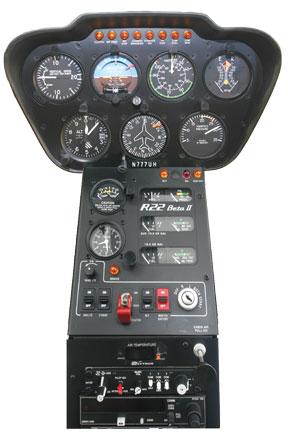
issue in just over a decade of ownership.
Most people say the R22 is one of the most difficult helicopters to fly, because of its sensitivity, low rotor inertia, and some other quirks that are addressed in the SFAR 73 requirements, with which pilots of this bird and the R44 must comply. My opinion is this helicopter is as safe, or even safer, than other machines out there, when properly flown and respected.
I operated this aircraft for over three years, in Denver, Colorado, and encountered no problems in the high-altitude regime. I found it will operate at max gross weight at 9500-foot density altitudes, if flown smoothly and carefully. That to me is an impressive and desirable feature, for what I guess could be called an entry-level machine in the world of helicopters.
My aircraft has every option that Robinson offered in 2000, and my only complaint is the factory-installed attitude indicator option still doesnt function properly even after two overhauls. I would probably leave that one off the list on my next bird, to save a little weight and maintenance. Keep in mind, R22s and R44s are not allowed flight in instrument conditions, even though the IFR trainer equipped models can be used to certify a pilot for an instrument ticket.
Factory prices on the R22 have close to doubled since my purchase in March 2000, so I find it better to keep this machine, instead of trading for a newer one. I am facing the 12-year overhaul in about 18 months, and estimate around $100,000 for a field overhaul, to comply with this requirement, and reset the 12-year/2200-hour clock back to the beginning, on what will likely be a 1400-hour machine at that
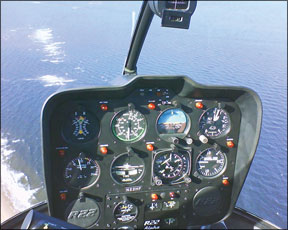
time.
My insurance has gotten down to around $4800 annually. When I added my son, they rated him as a student pilot the first year, which upped my annual premium closer to $8700, for good coverage. Next year I am told the premium will be reduced greatly now that he has a rotorcraft ticket.
After flying more than 50 kinds of aircraft in my flying career, the R22 is definitely at the top of my favorite list.
Jeff Abrams
Ocala, Florida
I have been flying R22s for the last 18 years. For the past 13 years, I have specialized in taking up aerial photographers with my R22 Mariner. I find it to be an excellent platform for photographers and they like it because it is cheaper to rent than other helicopters, and faster than helicopters of comparable size. It is responsive and agile. It does command constant attention to wind speeds and direction, and one must be aware that it has a low inertia rotor system. Things can happen fast with the R22. I compare flying the Robbie to driving a small sports car instead of a full-size car or truck.
Maintenance on the helicopter is easy. As helicopters go, it is inexpensive to operate. Having 2200 hours between overhauls is a plus. I have over 6000 hours and two overhauls on my aircraft with no problems. I find it a reliable, honest machine.
Anne Umphrey
Concord, Massachusetts

